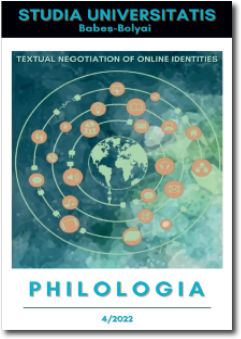THE ARTIST’S WEBSITE. DISCOURSE FEATURES OF ONLINE IDENTITY AND BRAND
DOI:
https://doi.org/10.24193/subbphilo.2022.4.12Keywords:
Internet communication, WWW, digital genres, discourse features, artist identity and brandingAbstract
The Artist’s Website. Discourse Features of Online Identity and Brand. The present study aims to reveal those discourse particularities displayed by the artist’s home page/website (used interchangeably for our current purposes) as a device to create an artist’s online identity. Specific methods (and steps) throughout the process of creating an online identity overlap with the advertising strategies of branding. Our interest concerns the discourse strategies involved in the two activities in the context of online communication. The particularities of the artist’s home page have been studied from a genre analysis perspective. The aim is to demonstrate that the genre features of the home page (as a cyber genre) determine or at least influence the site’s content. The present research also aims to determine how the content is negotiated within the website’s structure to serve the communicative goals of establishing an online identity and an artist’s brand. The findings reveal several discourse strategies at play to reach the final purpose and that they belong to advertising and e-commerce, on the one hand, and the specialized field of the visual arts, on the other.
Article history: Received 29 July 2022; Revised 7 October 2022; Accepted 6 November 2022; Available online 20 December 2022; Available print 30 December 2022.
REZUMAT. Website-ul artistului. Trăsături discursive ale identității sale virtuale și brandului său. Prezentul studiu are ca scop decelarea particularităților discursului ce caracterizează website-ul artistului/pagina web (termeni folosiți aici interschimbabil) văzut/ă ca instrument pentru crearea unei identități artistice virtuale. Metodele specifice (și unii pași) ale procesului de creare a unei identități artistice virtuale se suprapun peste strategiile publicitare ale brandingului. Ne interesează aici strategiile discursive implicate în cele două activități, în contextul comunicării virtuale. Particularitățile paginii web a artistului sunt studiate din perspectiva analizei genurilor. Scopul este de a demonstra că trăsăturile generice ale paginii web a artistului (ca gen virtual) determină, sau cel puțin influențează, conținutul site-ului. Prezentul studiu urmărește de asemenea să afle cum este negociat conținutul în interiorul structurii site-ului, pentru a servi scopurilor comunicaționale de a crea identitatea virtuală a artistului și brandul său. Rezultatele prezentei cercetări disting diverse strategii discursive ce conlucrează pentru acest scop și faptul că ele aparțin atât sferei publicitare și a comerțului online, cât și domeniului artelor vizuale.
Cuvinte-cheie. Comunicare virtuală, WWW, genuri virtuale, particularități ale discursului, identitate și brand ale artistului
References
Benjamins, Steve. 2022. “45 Examples Of Stunning Artist Websites.” SiteBuilderReport. January 4. Accessed March 16, 2022. https://www.sitebuilderreport.com/inspiration/artist-websites.
Bhatia, Vijay. 1993. Analysing Genre: Language Use in Professional Settings. Pearson Education Limited, Harlow: Longman Group, U.K. Limited.
Crețiu, Anda-Elena. 2013 (a). “The Blogging Artist. A Genre-Analysis Approach to Teaching English for Art Purposes.” Tarih Kültür ve Sanat Araştırmaları Dergisi (Journal of History Culture and Art Research), 2 (2) The Special Issue on “English Studies”:1-29.
Crețiu, Anda-Elena. 2013 (b). “‘Artspeaking’ about Art. Discourse features of English for Art purposes.” Diversitate Culturală și Limbaje de Specialitate—mize și perspective. Cluj-Napoca: Casa Cărții de Știință: 40-50.
Crowston, Kevin and Marie Willaims, 1997. “Reproduced and emergent genres of com munication on the worldwide web.” Proceedings of the 30th Hawaii Interna tional Conference on System Sciences. Los Alamitos, CA: IEEE Computer Society.
Dillon, Andrew, and Barbara Gushrowski . 2000. “Genres and the Web - is the home page the first digital genre?” Journal of the American Society for Information Science, 51(2): 202-205.
Fairclough, Norman. 1992. Discourse and Social Change. Cambridge: Cambridge: Polity Press.
Flowerdew, Lynne. 2005. “An integration of corpus-based and genre-based approaches to text analysis in EAP/ESP: countering criticisms against corpus-based methodologies.” English for Specific Purposes 2: 321-332.
Herring, Susan. 2004. “Computer-mediated discourse analysis: An approach to researching online behavior.” In Designing for Virtual Communities in the Service of Learning, edited by R. Kling, & J. H. Gray, S. A. Barab :338-376. New York: Cambridge University Press. http://ella.slis.indiana.edu/~herring/cmda.pdf.
Herring, Susan C. 2008. “Language and the Internet.” In International Encyclopedia of Communication, edited by W. Donsbach: 2640-2645. Blackwell Publishers, available at https://ella.sice.indiana.edu/~herring/lg.inet.pdf.
Herring, Susan C. 2010. “ Web content analysis: Expanding the paradigm.” In The International Handbook of Internet Research, edited by J, M. Allen, & L. Klastrup Hunsinger: 233-249. Berlin: Springer Verlag, https://ella.sice.indiana.edu/~herring/webca.preprint.pdf.
Herring, Susan. 2011. “Commentary.” In Digital discourse: Language in the new media, edited by C. Thurlow & K. Mroczek: 340-347. New York: Oxford University Press, http://ella.slis.indiana.edu/~herring/commentary.2011.pdf.
José, Luzón Marco Marià. 2002. “A Genre Analysis of Corporate Home Pages.” LSP & Professional Communication, 2(1): 42-56.
McKinnon, Jenni. 2022. “12 Types of Websites (examples).” Website Setup. February 9. Accessed March 5, 2022. https://websitesetup.org/types-of-websites-examples/.
Swales, John. 1990, 8th printing 2001 . Genre Analysis. English in academic and research settings. Cambridge: Cambridge University Press.
Swales, John. 1981. Aspects of article introductions. Aston ESP Research Report No. 1. Birmingham: Language Studies Unit. University of Aston in Birmingham.
Whithfield, Hannah. 2021. “Types of Websites: 11 Most Popular & How to Create Them.” WebsiteBuilderExpert. October 5. Accessed March 05, 2022.
Selected corpus:
https://benjaminhardman.com/about, accessed July 27, 2022
https://melvolkman.com/pages/about, accessed July 27, 2022
http://www.andreamanningart.com/bio, accessed July 27, 2022
http://philippajrice.com/about, accesssed July 27, 2022
https://alextranphotography.com/info/, accessed July 27, 2022
https://www.sophiekahn.net/bio, accessed July 27, 2022
Downloads
Published
How to Cite
Issue
Section
License
Copyright (c) 2022 Studia Universitatis Babeș-Bolyai Philologia

This work is licensed under a Creative Commons Attribution-NonCommercial-NoDerivatives 4.0 International License.





 ©Studia Universitatis Babeş-Bolyai Philologia. Published by Babeș-Bolyai University.
©Studia Universitatis Babeş-Bolyai Philologia. Published by Babeș-Bolyai University.